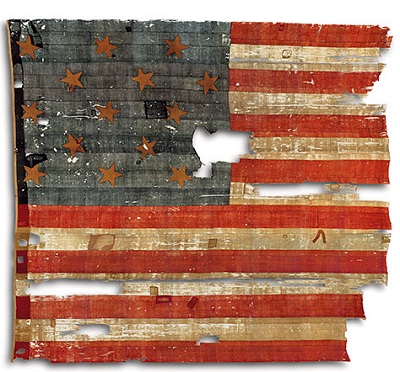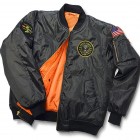This Day in History: The Star-Spangled Banner

“Oh, say does that star-spangled banner yet wave / O’er the land of the free and the home of the brave” – Francis Scott Key
Although the lyrics were originally written as a poem in 1814, it wasn’t until March 3, 1931 that President Herbert Hoover signed the congressional resolution that made “The Star-Spangled Banner” our country’s national anthem.
Francis Scott Key wrote the poem “Defence of Fort M’Henry” on September 14, 1814 after he witnessed the British ships in the Chesapeake Bay bombing Fort McHenry during the Battle of Baltimore in the War of 1812. During the battle he and fellow attorney John Stuart Skinner were aboard a British ship on a truce mission to make a prisoner exchange for Dr. William Beanes. Inspired by the flag that flew victoriously above the fort after the Americans had won the battle, he wrote the poem which was later set to music by John Stafford Smith to the tune of a popular British song. It was eventually renamed “The Star-Spangled Banner.”
The lyrics were first printed in the Baltimore Patriot and The American on September 20, 1814. The song quickly became popular and 17 additional newspapers printed it. The first public performance of the song took place in October at a tavern in Baltimore.
First recognized in 1889 for official use by the U.S. Navy, it was later recognized in 1916 by President Woodrow Wilson, who ordered the song to be played at military and other political functions. In 1930, the Veterans of Foreign War started a petition for the US to officially recognize “The Star-Spangled Banner” as the country’s national anthem. Prior to 1931, “My Country, Tis of Thee,” America the Beautiful,” “Yankee Doodle” and “Hail, Columbia” were the patriotic songs used at official functions in the U.S.
Five Fast Facts about “The Star-Spangled Banner”
First printed in Baltimore, only two known copies of the poem are believed to exist today.
Performing the national anthem at every baseball game began during World War II.
Known today for writing “The Star-Spangled Banner,” Francis Scott Key was a successful attorney whose poems were previously shared only with close family and friends.
The Star-Spangled Banner flag, with its 15 stars and 15 stripes, is on display in the Smithsonian’s National Museum of American History in Washington, D.C.
Originally written with four verses, Oliver Wendell Holmes wrote a fifth verse in 1861 to support the Union cause in the Civil War. All four original verses end with “O’er the land of the free and the home of the brave.”
“The Star-Spangled Banner,” as well as other patriotic songs like “America the Beautiful” and “God Bless America” honor our nation and the freedom it represents. Veterans Commemoratives (vetcom.com) honors our Veterans who have helped to preserve the strength and unity of our nation and proudly honors our flag by sending each customer a free American Flag lapel pin with each purchase.
Related products you may like:
Testimonials:
-
I received my United States MA-1 Bravo Jacket yesterday and I am very pleased with it. Thanks
Charles W
-
Thank you very much for the two beautiful garments! Both the MA1-Bravo Jacket and the Concealed Carry Soft Shell Vest fit perfectly and are tailored to perfection. They are rugged and warm, exactly what I was looking for.
Ed J.
-
I received the jacket this past Wednesday. I just love it. Good quality, feels great, and looks sharp. I have been looking for such a jacket the past few years and have finally found it.
Edward A.
-
Dear Vetcom, Received the MA-1 Bravo Jacket yesterday. Thank you so very much, made a Veteran very happy. Was so hoping to have it on time for him to wear on Veterans Day and you made sure it was here in time. The jacket is beautiful and my husband just loves it. Again, thank you so very much and God bless.
Jessie H.







